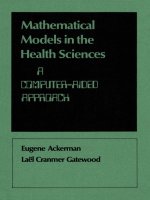Health Sciences 4700 Spring 2009 - Chapter 9
Bạn đang xem bản rút gọn của tài liệu. Xem và tải ngay bản đầy đủ của tài liệu tại đây (185.19 KB, 38 trang )
Health Sciences 4700
Spring 2009
Chapter 9
Decision Support Systems
What are decision support
systems (DSSs)?
Computer systems that assist decision
makers
Combine “machine” or “artificial intelligence” with
information about the domain of interest
Intended to make knowledge more readily
available at the point of care
Simple DSSs
CPOE system with drug interaction alerts
EHR with alerts for missing or unknown
information
Database with structured queries to find
relevant information
Differential diagnosis systems (e.g.,
FirstConsult)
Components of an advanced
DSS
Data management system
Model management system
Computations that represent domain models
Knowledge-based management system
Database and query system
“Captured” knowledge and reasoning
User interface
Input/output, documentation
Types of advanced DSSs
Expert systems
Neural networks
Intelligent agents
Knowledge management systems
Information systems
Group support systems
Enterprise planning and management
systems
Characteristics of DSS
Used in un-/semi-structured decision
contexts
Support decision makers, not replace them
Rely on data and models
Generally developed using an evolutionary,
iterative process
Focus should be on complete system
(including people and procedures, not just
computers)
Application domains
Administrative decision support
Access and organization of data
Analysis of data
Analysis of multiple data sources
Accounting and modeling of data
Forecasting from data
Optimization and comparison of alternatives
Suggestions of action based on comparisons
Application domains
Clinical decision support
Access to information (EHR)
Analysis of data (single or multiple sources)
Diagnosis
Recommendations for treatments/procedures
Why DSSs?
Information overload
Experience and expertise is learned over
many years
Current research and evidence far outstrips any
individual’s capacity to absorb it
Senior clinicians are often not involved from direct
care
Knowledge and reasoning can help prevent
medical errors
Applications of DSS
Reminders and alerts
Prescribing systems
Therapy planning and critiquing
Provide complete information at point of care
Identify inconsistencies, errors, omissions
Image recognition
Identify potential abnormalities, changes
Applications of DSS
Diagnostic systems
Help identify conditions based on symptoms
Among earliest examples of DSS
Support evidence-based practice
May provide structured access to research
Elsevier’s MD/FirstConsult (www.mdconsult.com)
Are DSSs effective?
In principle, they should be!
Improved patient safety
Improved quality of care
Improved efficiency
Are DSSs effective?
However …
Research isn’t completely convincing, particularly
in terms of patient outcomes
Design may not have user in mind
Reminders and alerts are valuable, but if they interfere
with care, they won’t be used (pop-ups)
May be perceived as de-humanizing care
Neither caregivers nor patients are willing to turn over
decision making to a “machine”
DSS can reduce non-data driven interaction
Understanding how DSSs work
Clinical decision making generally involves
“semi-structured” decisions
How can we represent knowledge in a DSS?
Some but not all information is known
Descriptive knowledge: facts and data
Practical knowledge: steps and instructions
Inferential knowledge: reasoning from theory and
facts (“intelligence”)
How do we maintain currency of knowledge?
Artificial intelligence (AI)
AI is field of computer science that attempts
to make computers “reason”
Study of intelligent behavior and attempts to create
computer systems that behave that way
Spectrum of AI ranges from “weak” to
“strong”
Weak AI assumes that some reasoning can be
approximated through programming
Strong AI believes that computers can think like
humans (or vice versa)
Areas of AI
Robotics
Pattern recognition
Expert systems*
Most applicable to decision support systems
Types of expert systems
Rule-based systems
Case-based reasoning
Fuzzy logic
Bayesian networks (belief systems)
Neural networks
Rule-based systems
Rule-based systems are based on “expert
knowledge” rather than data
Attempt to recreate the thought processes of a
diagnostician or other knowledgeable person
How would that person respond to a given set of
circumstances or conditions?
Components include knowledge base, inference
engine, and user interface
Rule-based systems
A patient complains of difficulty breathing
No fever means the patient probably doesn’t have
a respiratory infection
A normal chest X-ray will probably preclude
pneumonia (and corroborates the lack of a
respiratory infection)
A TB skin test and a normal chest X-ray also
strengthens the lack of infection hypothesis
Patient reports problem occurs after exercise
Rule-based systems
Patient reports problem occurs after exercise
No history of cardiac or pulmonary disease
Nature of the problem is wheezing and shortness of
breath, which is characteristic of asthmatics
Most likely conclusion: exercise-induced
asthma
How do you get a computer system to act like
an expert?
Rule-based systems
Knowledge in expert systems is represented
as rules or IF-THEN statements
Programming takes inputs through the user
interface
Inputs are passed to the inference engine, which
applies the rules in a logical pattern
Result is returned through the user interface
Rule-based systems
IF (condition) THEN (result)
ELSE alternative result
--------------------------------------------------------------“condition” is a Boolean value that compares inputs to
knowledge
IF “condition” is true THEN “result” is executed
ELSE [“condition” is false] “alternative result” is
executed
Alternative can be another IF-THEN, and so forth
Rule-based systems (example)
IF dipstick = pink THEN test <- normal;
IF dipstick = lilac AND symptoms = none
THEN test <- normal;
…
Note that if “dipstick” has the value “pink” then the first
condition is true and “test” is assigned the value
“normal”
If “dipstick” is “pink”, then the second condition cannot
be true, no matter what the value of “symptoms” is!
User interface would return the value of “test”
Rule-based systems (example)
IF dipstick = pink THEN test <- normal
ELSE IF dipstick = lilac AND
symptoms = none
THEN test <- normal
ELSE …
Note that once “test” is assigned the value “normal” no
other execution is necessary!
In previous example, you would have to ensure that
“dipstick” was NOT pink for every subsequent
statement in order to make a correct diagnosis
Rule-based systems
Problems with rule-based systems
Extracting complete knowledge is difficult
There is always some measure of uncertainty in a rule
Complex systems require a large number of rules
Domains tend to be narrowly focused
Maintaining currency is difficult
Input range is often large
Interaction with system tends to be difficult









